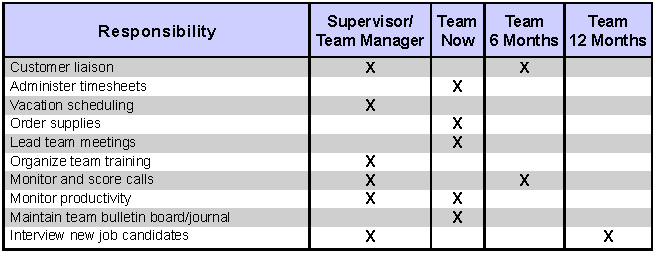Building And Managing Call Center Teams
Most call center organizations are built around a team concept. Some call centers have teams that are nothing more than a group of individuals that happens to report to the same person, or perhaps does the same kind of work, but there is no real interaction and teamwork. Other call centers have empowered teams that work together as a cohesive group and take responsibility for the productivity and success of the unit.
There has been much research to show that self-directed work teams foster continuous improvement and result in better quality, productivity and customer service. People who work on functional teams are happier with their jobs than people who don't belong to a team. Team members feel better about their work because they are more involved in their jobs and see a link between their own accomplishments and those of the team and the organization.
As a manager, there is much you can do to make your team a success. Clearly defining the roles and responsibilities of the team will help ensure your team members know what is expected now and into the future. A team framework, with ever-increasing responsibilities, can provide career definition and help map out training and development for the team as a whole as well as individuals.
Defining Roles And A Team Matrix
As you develop your team, it will be useful to “charter” it. A team charter will define the team's purpose and objectives. The more precisely you can define the purpose and objectives of the team, the faster your team members will understand where they're headed and how their roles fit into the bigger overall plan for the call center.
The team charter should answer three important questions:
• How much leadership will team members assume?
• What outside groups will the team need to coordinate?
• How will the team measure its effectiveness?
A key element in preliminary setup and ongoing team development is identifying the roles that team members and the leader will play. As a supervisor, you should define what responsibilities you will assume and which ones will be delegated to your team. Some of these roles and responsibilities can shift from you to the team as the team matures.
A matrix of team roles and responsibilities should be shared with everyone on the team so all members know what the mission and goals of the team are as well as who is doing what now and into the future. You may want to define responsibilities for the current time, six months from now, twelve months from now and so on. The matrix should show not only current responsibilities, but what the team is preparing to do for the future. A sample team responsibilities matrix is shown in Table 1.
 |
A team responsibilities matrix serves as a roadmap to see where your team has been, where it is now and where it is going. In addition to the matrix shown above, you will need to develop a matrix by individual that shows each team member's responsibilities. Clarifying roles helps your team members avoid misunderstandings and identifies new opportunities for development. It shows who is currently fully occupied and who may have room for additional responsibilities. It can also help you identify training and development opportunities as your team members assume more responsibilities. It can also help people outside the team determine the best contact points for their needs.
It is common for a team to get “off track” and find itself going in too many directions at once. When that happens, it's difficult for the team to focus on its primary goals and objectives, which can frustrate both you and your team members. If your team members get off track, it's your responsibility as leader to work with them to reexamine their focus areas.
To help the team stay focused, you may need to help team members prioritize. Have each member make a list of responsibilities and work together as a team to prioritize their efforts. You may still keep all the tasks on the list, but items may need to move up or down the list so the team can readjust its focus to its top priority - meeting customer needs and expectations.
You will also want to ensure that team members are pacing themselves appropriately. To foster development, you may have shifted responsibilities to team members too soon in the learning and development cycle. Assess the tasks of each role and make sure team members have the appropriate skills and knowledge, or they may be trying to do too much too soon.
Always keep a focus on the team process and how the team can do the work better and more efficiently. This may involve rethinking processes and procedures. Be flexible and learn to adapt to inevitable surprises and conflict that are part of every team effort.
Penny Reynolds is a founding partner of The Call Center School, a company that provides a wide range of educational offerings for call center professionals. Penny is a popular industry speaker and is the author of numerous call center management books, including Call Center Staffing: The Complete, Practical Guide to Workforce Management and Call Center Supervision: The Complete Guide for Managing Frontline Staff. She can be reached at 615-812-8410 or by e-mail at [email protected].
|

